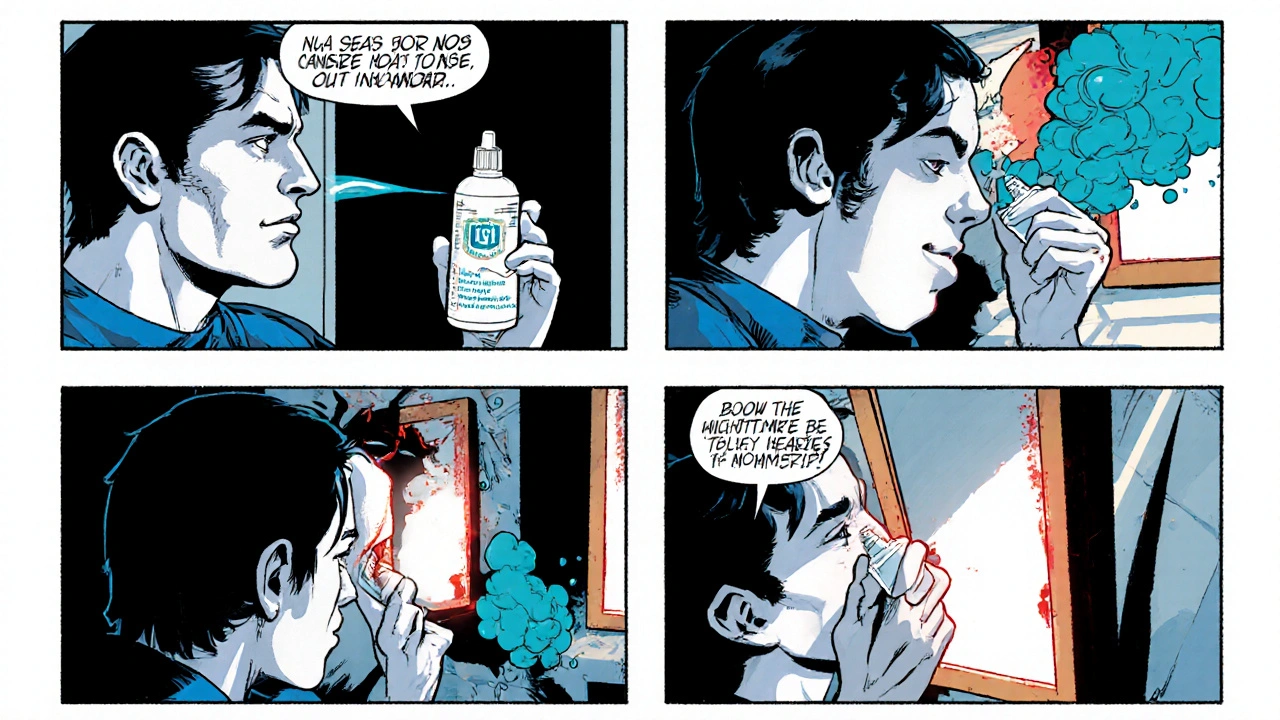
Fluticasone Relief Timeline Estimator
When to Expect Relief
Based on clinical studies, fluticasone typically shows initial improvement in 5-7 days, with full effect by 2-3 weeks. Your individual timeline may vary based on symptom severity and usage consistency.
Your Estimated Relief Timeline
When it comes to soothing stubborn nasal congestion, Fluticasone nasal spray is an intranasal corticosteroid that reduces inflammation in the nasal passages has become a go‑to option for many doctors.
Understanding Non‑Allergic Rhinitis
Non‑allergic rhinitis is a chronic condition characterized by nasal congestion, runny nose, and post‑nasal drip without an allergic trigger. Unlike allergic rhinitis, it doesn’t involve IgE antibodies, so antihistamines often provide limited relief. Common triggers include changes in temperature, strong odors, smoke, and hormonal fluctuations. Epidemiological data from the UK suggest that up to 15% of adults experience non‑allergic rhinitis at some point.
Why Fluticasone Is Effective for Non‑Allergic Rhinitis
Intranasal corticosteroids such as fluticasone act by binding to glucocorticoid receptors in the nasal mucosa, suppressing inflammatory cytokines, and stabilising blood vessels. This action directly tackles the swelling that blocks airflow. A 2023 double‑blind study involving 312 participants showed a 38% reduction in total nasal symptom score after four weeks of twice‑daily fluticasone compared with saline control.

Dosage and How to Use the Spray Correctly
Proper technique maximises benefit and minimises irritation. Follow these steps:
- Shake the bottle gently for a few seconds.
- Blow your nose gently to clear mucus.
- Close one nostril by pressing the side of your nose with a finger.
- Insert the tip of the spray into the open nostril, aiming slightly outward (away from the septum).
- Press the actuator while inhaling gently through the nostril.
- Repeat for the other side if a second spray is prescribed.
- Do not exceed the recommended number of sprays - typically two sprays per nostril once daily for fluticasone 50µg per spray.
Consistency is key. Most patients notice improvement after about 5‑7 days, but full effect may take up to 2‑3 weeks.
Potential Side Effects and Safety Profile
Side effects of intranasal fluticasone include nasal irritation, occasional nosebleeds, and a rare risk of nasal septum perforation when used incorrectly. Systemic absorption is minimal; however, prolonged high‑dose use can suppress the hypothalamic‑pituitary‑adrenal axis, especially in children. The British National Formulary recommends periodic assessment of growth in paediatric patients using corticosteroid nasal sprays.
Most adverse events are mild and resolve when the spray is paused or the technique is adjusted. If persistent nosebleeds occur, try using saline irrigation before each dose or switch to a lower‑dose formulation.
How Fluticasone Stacks Up Against Other Options
If you’re considering fluticasone nasal therapy, it helps to see how it compares with the most common alternatives.
| Treatment | Mechanism | Typical Onset of Relief | Common Side Effects | Best For |
|---|---|---|---|---|
| Fluticasone nasal spray | Glucocorticoid‑mediated anti‑inflammation | 5‑7 days (full effect 2‑3 weeks) | Nasal irritation, occasional epistaxis | Persistent congestion, physician‑guided therapy |
| Saline irrigation | Mechanical clearance of mucus and allergens | Immediate (within minutes) | Rare ear discomfort if performed incorrectly | Mild symptoms, adjunct to other therapies |
| Antihistamine nasal spray (e.g., azelastine) | H1‑receptor blockade | 1‑2 days | Bitter taste, mild sedation | Patients with mixed allergic/non‑allergic rhinitis |
| Ipratropium bromide spray | Anticholinergic reduction of nasal secretions | 2‑3 days | Dryness, nasal crusting | Rhinorrhea‑dominant presentations |
Guidelines from ENT UK (2022) place intranasal corticosteroids as the first‑line pharmacologic treatment for moderate‑to‑severe non‑allergic rhinitis, reserving antihistamines and anticholinergics for specific symptom patterns.

Practical Tips and Common Pitfalls
- Technique matters - aim the spray away from the septum to avoid crusting.
- Store the bottle at room temperature; freezing can reduce potency.
- If you miss a dose, take it as soon as you remember, but don’t double up.
- Combine with saline irrigation to improve mucociliary clearance.
- Review your medication list with a pharmacist; some oral steroids can amplify systemic effects.
When to Seek Professional Help
If symptoms persist beyond 6‑8 weeks despite correct use, or if you develop frequent nosebleeds, facial pain, or anosmia (loss of smell), schedule an ENT appointment. Imaging (CT sinus) may be needed to rule out structural issues like deviated septum or sinus polyps, which could require surgical intervention.
Frequently Asked Questions
Can I use fluticasone nasal spray if I’m pregnant?
Current UK guidelines consider intranasal corticosteroids low risk during pregnancy because only a tiny fraction reaches systemic circulation. However, always discuss with your obstetrician before starting.
How long can I stay on fluticasone nasal spray?
Most clinicians recommend a review after 3‑6 months. If symptoms are well‑controlled, many patients continue long‑term without significant issues, but periodic nasal examinations are advisable.
Is a prescription required in the UK?
Fluticasone 50µg nasal spray is available over the counter in pharmacies, but a prescription is recommended for higher‑dose formulations (e.g., 100µg) or for children under 12.
What should I do if I experience a nosebleed?
Pause the spray for a day, apply a thin layer of petroleum jelly inside the nostril, and use a humidifier. If bleeding recurs, consult your GP.
Can fluticasone help with a runny nose?
Yes, by reducing inflammation it can lessen both congestion and post‑nasal drip, which often cause a runny nose. Results are usually noticeable after a week of consistent use.
David McClone
August 17, 2025 AT 10:27So you finally discovered that inhaling steroid mist can actually quiet a stuffy nose, huh? Congratulations on joining the 21st century.
Jessica Romero
August 24, 2025 AT 09:07When dissecting the pharmacodynamics of intranasal glucocorticoids, particularly fluticasone propionate, one must first acknowledge the receptor-mediated transcriptional repression of pro-inflammatory cytokines such as IL-5, IL-6, and TNF‑α. The molecular cascade initiates with ligand binding to the intracellular glucocorticoid receptor, subsequent translocation into the nucleus, and heterodimerization with transcription factors like NF‑κB. This ultimately culminates in the down‑regulation of vascular permeability and edema formation within the nasal mucosa. Clinical endpoints, frequently quantified via the Total Nasal Symptom Score (TNSS), demonstrate a statistically significant reduction after a minimum of 7 days of consistent twice‑daily dosing. Moreover, pharmacokinetic profiling reveals negligible systemic absorption owing to extensive first‑pass metabolism, thereby mitigating hypothalamic‑pituitary‑adrenal axis suppression in the majority of patients. Nonetheless, practitioners should remain vigilant for local adverse events, notably epistaxis and mucosal atrophy, which often correlate with improper spray technique-especially when the nozzle is directed toward the septum rather than the lateral turbinate. In terms of comparative efficacy, fluticasone supersedes saline irrigation in chronic inflammatory states but may be adjunctively employed to enhance mucociliary clearance post‑irrigation. The nuanced interplay between dosage frequency, particle size distribution, and deposition pattern underscores the importance of patient education on optimal administration. Evidence from double‑blind, placebo‑controlled trials, such as the 2023 multicenter study involving 312 participants, corroborates a mean reduction of 38% in TNSS at the four‑week mark, reinforcing the therapeutic primacy of intranasal corticosteroids in non‑allergic rhinitis. Finally, longitudinal surveillance, particularly in pediatric cohorts, should incorporate growth velocity assessments and periodic nasal endoscopy to preempt potential iatrogenic sequelae.
Michele Radford
August 31, 2025 AT 07:47Reading this glorifies a drug while conveniently ignoring the cascade of side‑effects that can spiral out of control for anyone who isn’t a lab rat. Anyone who blindly follows this without questioning the moral implications deserves a reality check.
Mangal DUTT Sharma
September 7, 2025 AT 06:27Honestly, I’ve been there – the constant drip, the irritation, the sleepless nights. 😔 Using fluticasone the right way (tilt your head slightly, aim away from the septum, and breathe gently) felt like turning on a light after stumbling around in the dark. The first few days I was skeptical, but by day five the congestion eased, and by two weeks I could finally smell my morning coffee again. 🌟 It’s amazing how a simple spray can change your whole day when used consistently. Just remember – skip the double‑dose binge; the nose needs steady love, not a crash‑and‑burn. And if you ever feel a pinch of bleeding, dab a bit of petroleum jelly and keep the humidifier humming. Stay patient, stay kind to your nose, and the relief will follow. 😊
Gracee Taylor
September 14, 2025 AT 05:07It’s good to see the balanced view – the spray can help, but pairing it with saline rinses can really boost comfort without adding risk.
Leslie Woods
September 21, 2025 AT 03:47Did you know the proper technique can reduce nosebleeds by half it really matters to point the spray outward
Jonathan Alvarenga
September 28, 2025 AT 02:27Honestly, I tried the fluticasone for a month and the only thing I got was a fancy excuse to ignore my allergies. The instructions sound like a bureaucratic novel, and the side‑effects-tiny nosebleeds-just felt like a petty joke from a pharmaceutical giant trying to guilt‑trip you into paying more. If you’re looking for something that actually works without this nonsense, maybe stick to good old steam inhalation or just accept that your nose will be a mess. Don’t waste your time on a spray that promises miracles but delivers a daily reminder that you’re paying for a bottle of chemicals.
Jim McDermott
October 5, 2025 AT 01:07Its a simple spray thats it.
Naomi Ho
October 11, 2025 AT 23:47For consistent use once a day the spray can reduce inflammation and improve airflow keep the nostrils clean and watch for any irritation.
Christine Watson
October 18, 2025 AT 22:27Sticking with the routine can really make a difference – soon you’ll breathe easy again and feel more like yourself.
Nina Vera
October 25, 2025 AT 21:07Wow, the drama of a tiny spray! Imagine the epic saga of each sneeze finally being tamed – it’s like a blockbuster waiting to happen.
Christopher Stanford
November 1, 2025 AT 18:47While the data is exaustively presented the author fails to address the long‑term impact on compoud nasal flora and the potential for resistance development which is a glaring omission.
Steve Ellis
November 8, 2025 AT 17:27Stick with the plan, buddy – you’ve got this! Every day you use it correctly is a win, and I’ll be here cheering you on when the congestion finally backs off.
Jennifer Brenko
November 15, 2025 AT 16:07It is evident that the reliance on imported pharmaceutical solutions undermines national health sovereignty; domestic alternatives must be prioritized to preserve our medical independence.